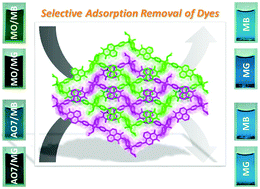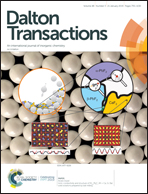Two-fold 2D + 2D → 2D interweaved rhombus (4,4) grid: synthesis, structure, and dye removal properties in darkness and in daylight†
Abstract
Compound [Cu(NI-mbpy-44)2(NO3)2]·4H2O (1, NI-mbpy-44 = N-(pyridin-4-ylmethyl)-4-(pyridin-4-yl)-1,8-naphthalimide) adopting a two-dimensional (2D) periodical rhombus (4,4) grid has been synthesized. This grid doubly interweaves in a parallel fashion to result in overall 2D + 2D → 2D networks with approximately 14% sufficient free volumes in which lattice H2O molecules reside. Dye removal studies show that 1 selectively adsorbs anionic methyl orange (MO) and acid orange 7 (AO7) over cationic methylene blue (MB) and malachite green (MG) from aqueous solutions containing single or mixed dyes in darkness at room temperature. The experimental isotherm data were analyzed using linear Langmuir and Freundlich isotherm equations; the results indicated that the Langmuir model showed a better fit for the adsorption of MO and AO7 over 1, with high dark adsorption capacities of 810 and 370 mg g−1, respectively, although there could also be other associated mechanisms. The dark adsorption kinetics of MO and AO7 over 1 obeyed the pseudo-second-order kinetic model. Electrostatic attraction appears to be the dominating mechanism for adsorptive removal of MO and AO7 by 1, whereas π–π stacking (MO and AO7) and hydrogen-bonding interactions (AO7) could also be responsible. Exploration of the adsorption performance of MO and AO7, including studying the kinetics in daylight, shows similar results to those obtained in darkness, indicating the negligible influence of daylight on the dye removal. Nevertheless, 1 could liberate NI-mbpy-44 and Cu(II) into water throughout the entire adsorption experiment, which could be a potential environmental hazard, this could cause secondary pollution and mean that 1 is impractical for use as an adsorbent candidate.



 Please wait while we load your content...
Please wait while we load your content...